John Capowski heads to four markedly different rivers for Trout fishing in Tuscany and Umbria regions of Italy.
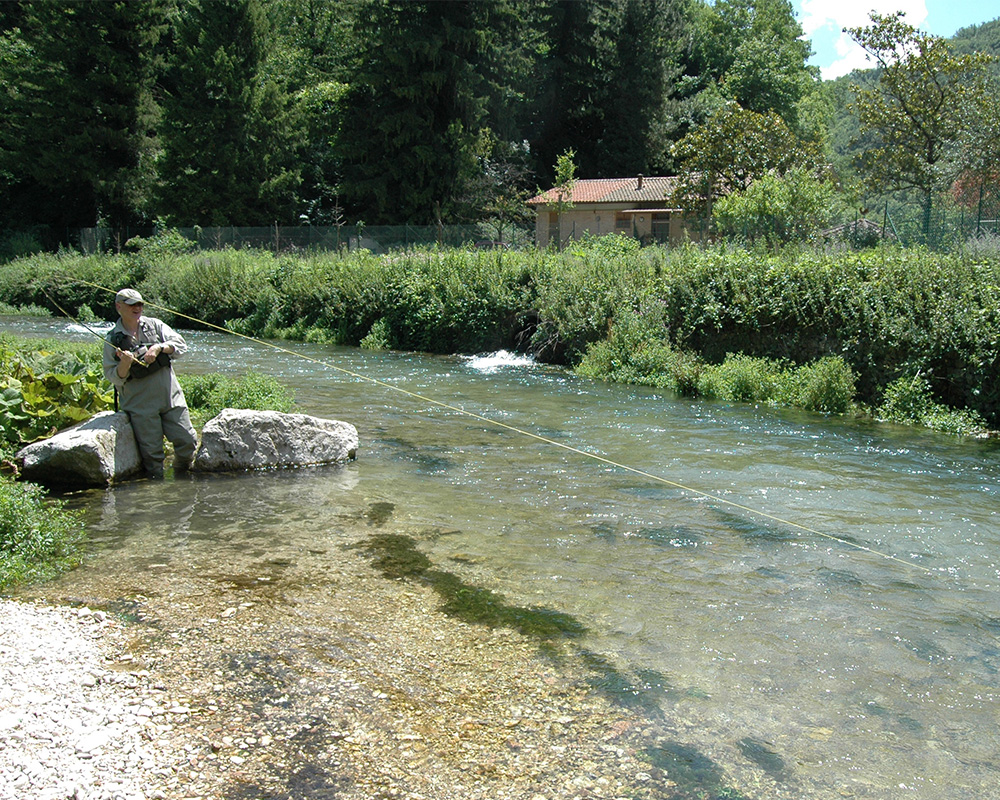
Into a Tuscan trout
Many of us know of Tuscany’s reputation for spectacular scenery, ancient fortified villages, wonderful wines, and women as hot as an August night in Lucca. But few, and I was among them, know about trout fishing in Tuscany, in particular of its quality dry fly fishing.
I found out about Italian trout fishing from my friend, Bill Harms, a retired English professor and extraordinarily talented bamboo rod-maker. Bill had travelled to Italy as the guest of Italian Bamboo Rodmakers Association (IBRA) after he published Split and Glued by Vincent Marinaro. Vince, the author of A Modern Dry Fly Code and In the Ring of the Rise, had introduced Bill to cane rod-making.
Setting up trout fishing in Tuscany trips
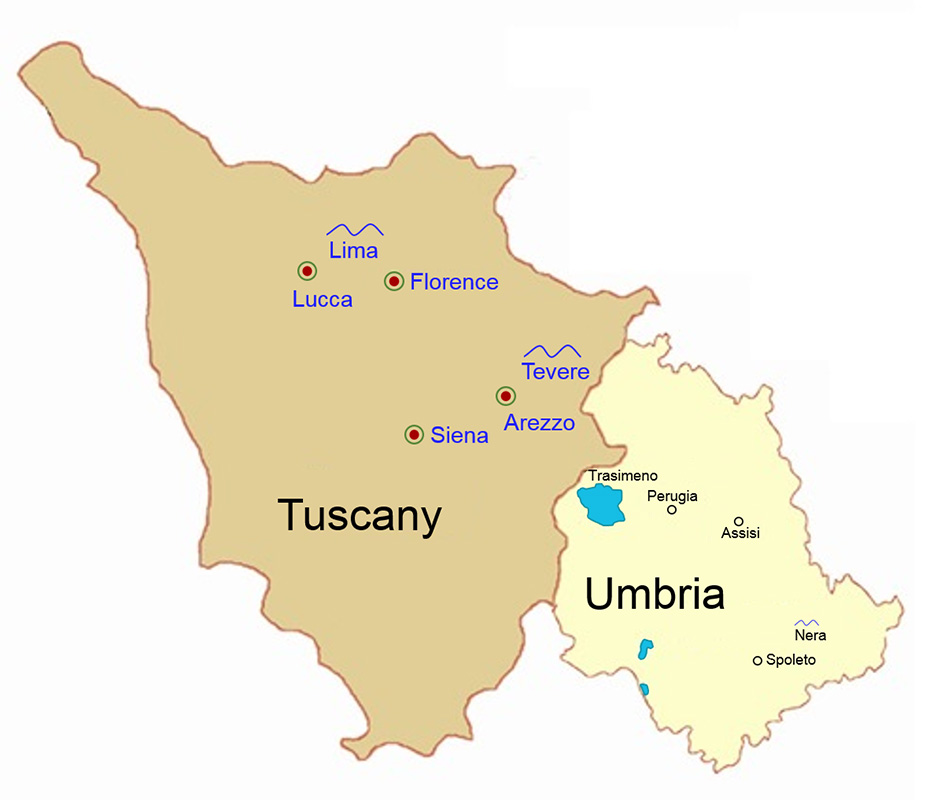
The regions
So en route to a friend’s wedding in Slovenia, I contacted Moreno Borriero, a fishing guide and one of Bill’s Italian fly fishing friends, and arranged to fish with him in Tuscany. Moreno was born and grew up in South Africa. In addition to being an avid fly fisher, Moreno is a cane rod-maker and one of the main figures behind IBRA. There are guides who are guides, but for me Moreno is a guide who quickly became a friend.
After my friend Michael’s wedding, his fifth (but that’s another story), I fished in Slovenia and then caught a train to Florence. If you go to Tuscany to fish for trout and are on your first trip there, visit Florence. Florence is Tuscany’s largest city and the home to both great architecture and great art.
Tourism opportunities
The Uffizi Gallery, once holding Florence’s administrative and judicial offices, is home to works by Michelangelo, da Vinci, and Botticelli, including his “Venus on the half-shell”.
The cathedral, built of white and grey marble, is a checkerboard of religious expression, and you can also see Michelangelo’s David and the Monastery of San Marco, where the monk’s former chambers each have a fresco by Fra Angelico.
The Arno River flows though the city and Ponte Vecchio, or old bridge, crosses the river; having been built in the 1300s, the bridge truly qualifies for the moniker. Now, as in the past, it is lined with shops and ateliers.
Trout fishing in Tuscany

A fine specimen
Florence is wonderful, but for this trip I was in Tuscany to fish.
Moreno picked me up at the rail station, and we headed south-east to Sansepolcro and the “Podere Violino,” a charming and modest hotel/villa on the edge of town, where we stayed while I fished the Tuscan and Umbrian streams.
In addition to the hotel and restaurant, Podere Violino has a dedicated space that serves as the clubhouse, workshop, and fly fishing museum for IRBA. That evening we had a classic Tuscan dinner of wild boar, beans, and fresh bread on the patio at Podere Violino.
After, Moreno tied a few guide flies – read, fast and simple – and I, having a shallow learning-curve, spent some time banging my head into the not ready for six-footers thresholds in the top floor of the several hundred year old building.
The Tiber
The next day we headed to the nearby “Tevere”, Tiber in English. A slow and sediment filled river in Rome, the Tevere flows south and adjacent to Sansepolcro, where it is a tail-water holding the southernmost population of grayling in Europe and a strong population of brown trout, including a variation with large orange spots, felicitously named “Trota di Michaelangelo.”
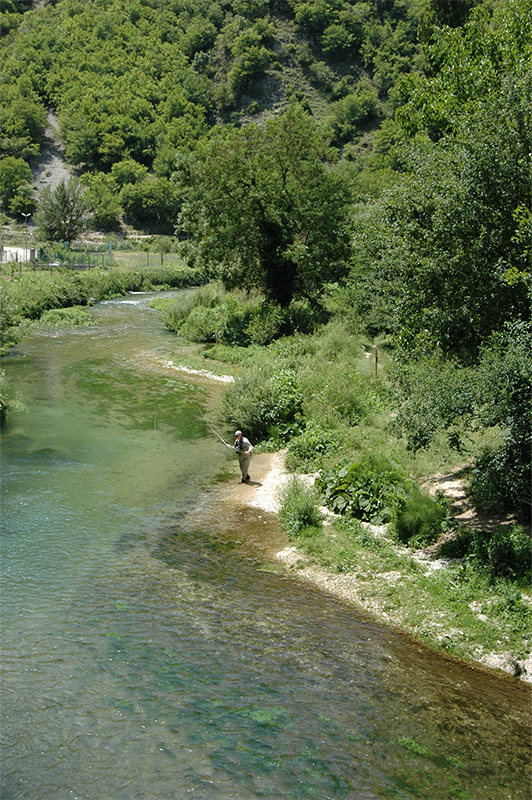
Gin clear water
While Michaelangelo may never have fished for trout, the brown trout variation named after him reminded me of the late author Richard Brautigan’s suggestion that, if Michaelangelo had worked as a lure designer for Gladding Tackle, he would have invented the ultimate trout lure – “The Last Supper.”
My introduction to the Tevere was just to the north of town on a long, slow pool nick-named the “Tail Water Tevere (TWT) University.”
The trout were rising, and fortunately for me, the apocryphal university degrees had not made the trout immune from dry flies, especially not from Moreno’s simple CdC fly named the “G-string.” An Hungarian client named the fly, but one is sometimes reluctant to mention the fly and its effectiveness.
When an elderly and proper looking British fly fisher on England’s Kennet asked what fly Moreno was fishing, Moreno demurely replied, “a soft hackle.” This notwithstanding, G-strings now boldly fill a compartment in my dry fly box and, as you might guess, the fly is sparsely tied. But that, too, is another story.
After I took a few trout, including “bella Trota di Michaelangelo,” in the TWT pool, we moved on to the faster water sections of the stream. Flies hatched during the day that both brought trout and grayling to the surface and were similar to the pmd’s and b-wo’s we would find on the tail-waters and spring creeks in the States.
While I didn’t take any large trout or grayling, the experience and Moreno’s relaxed and engaging company made for as wonderful a day, except for the next one, a fly fisher might have in Italy.
A few words on tackle for trout in the Tiber
Moreno is a cane rod-maker, and I have fished his rods during my trips to Tuscany. This was not only made possible by his generosity but also required on my first trip there after a Slovenian fly fishing guide, while setting up my Winston LT, broke the rod’s tip.
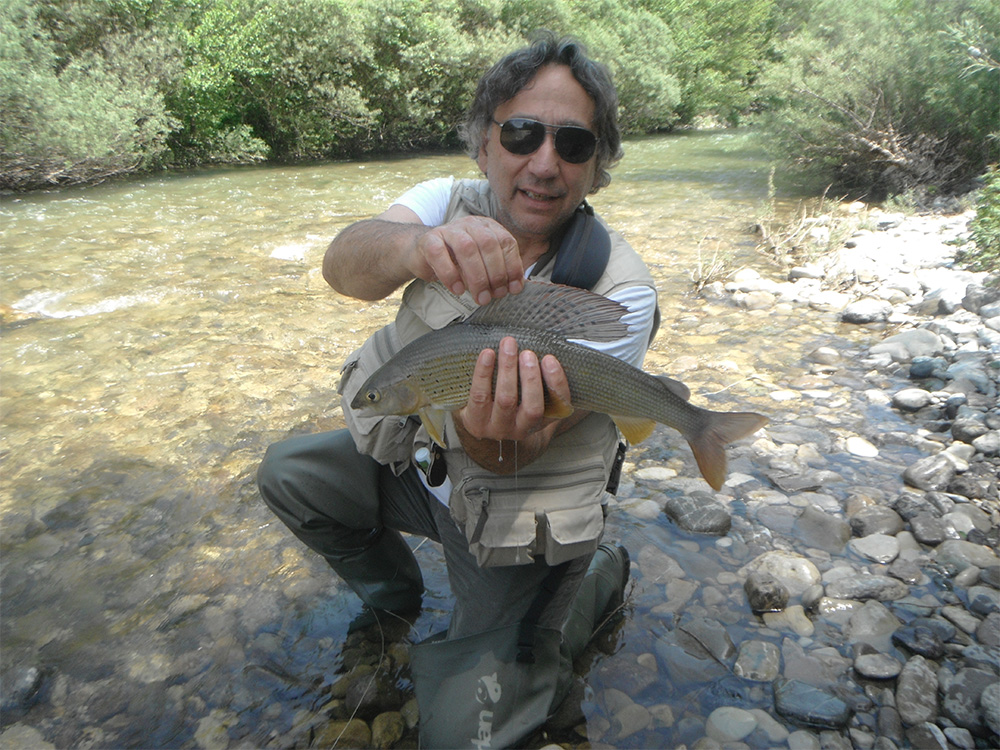
A lovely grayling, another great target species to frequent these waters
While fly fishers often describe bamboo fly rods made in the United States as having medium to medium-fast actions, the Italians build cane rods that are very fast and have tips that taper quickly. These actions are designed for accurately driving light lines and dry flies under the often present overhanging scrubs and branches. Their reels and even the flies, though with slight variations, are very much like our own.
The Nera
While the Tiber is a tailwater created with constant cold-water flows, the Nera, located about and hour-and-a-half south and east in Umbria, is a spring creek with the classic pools and large brown trout of those streams.
The drive into the Alps and to the Nera will take you past Assisi, the birthplace of St Francis and the Basilica di San Francesco, built from 1228 through 1253 to commemorate his life.
Like many Tuscan cities and hill towns, Assisi retains its early character and a walk is an architectural tour. Moreno will be glad to stop, but you will have to decide whether history and a possible religious pilgrimage are more important that day than brown trout.
The Nera, in the rugged Borgo Cerreto valley, is a higher gradient stream than most spring creeks and lacks their meandering flow.
While it has different genus than the aquatic weeds of the limestone streams near my home in south-central Pennsylvania, the appearance of the Nera’s stream-bed is similar; the weed-beds both channel the currents and are home for the insect life that produces its large browns.
Whilst I imagine that nymph fishing with cress bug and scud imitations would be effective, I was there for the Nera’s dry fly fishing.
Fishing CdC Duns to rising browns made for a wonderful morning’s fishing, but I suffered some temporary stream-side trepidation. Moreno had warned me that the vegetation held asp vipers, a beautifully patterned but highly poisonous snake quite common in Europe and responsible for the great majority of poisonous snake bites in Italy.
An academic, I was limited largely to travelling to Europe during summer breaks, and the Italian summers, even as far north as Tuscany, are hot. A midday break is welcome, and a small “ristorante” within a wader-clad walk of the Nera provides a wonderful spot to repair.
Luca Castellani, also a guide, Massimo Giuliani, another rod maker active in IBRA, his son Marco, Moreno, and I shared some wonderful pasta, perhaps a redundancy in Umbria and Tuscany, and regional wines. While sedated by a fine Chianti and a Nol di Montepulciano, we rallied for the evening rise and the best fishing of the day.
Back on the water, Luca found a couple rising fish cross-stream and gave the visitor first shot. After a few poor drifts to the eddy tight to the bank, I got the largest brown to rise and take my size 16 Tan Caddis, a fly that matched that evening’s predominate insect. Luca, with his often present video camera, recorded my effort to bring the fish, now taking advantage of a quickly flowing riffle, to Moreno’s net.
One needs to be a bit cautious when playing a large fish on a light-weight bamboo rod, particularly in front of its owner-maker. Luca took the obligatory “fish and grin” photo of Moreno, the brown, and this goofy-grinned author. To say it was a wonderful ending to a wonderful day would make me the master of the mundane. OK, I admit it.
The Lima
While the Nera is a spring creek and the Tevere a tailwater, the Lima has the character of a freestone river. Flowing through a magnificent valley in the Apaun Alps, north of Lucca, the Lima is the highest gradient stream of the three and home to a beautiful and native strain Mediterranean brown trout.
While genetically diluted by hatchery stockings, Moreno and others have worked to bring the variety’s genetics back to those of the originals.
Although I’m now used to buying licences on-line and in fly shops, Moreno and I stopped in a tavern near the stream to get my day-ticket. Unless your Italian is excellent and your sense of direction and GPS are equally strong, you’ll want a guide to help you navigate both the rural Italian roads and the licensing and local permit requirements.
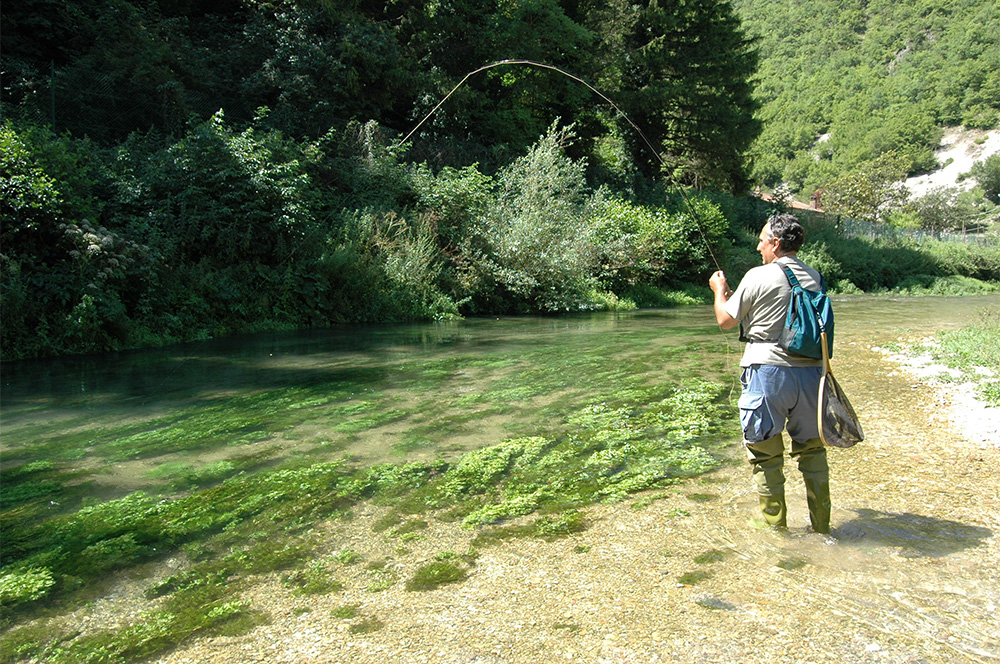
Fish on
A girlfriend once called me cheap, and, while I’ll cop to that, I’m not so foolishly frugal that I’d try to navigate arrangements for these fisheries on my own.
While the Lima is a freestone stream and its fish are not large, it is the most difficult of these three streams for the fly fisher. This is in part because the fish are wild, highly selective, and, unless they are rising, difficult to spot.
The Lima has long, slick pools where most of the fish hold, although one can take fish in the riffles as well. In the pools, one needs a great drift and a good imitation. At times, one can take fish in the riffles with various attractors, including Wulffs and larger caddis imitations. I took several, including one Moreno suggested was the largest fish of his season, on my favourite CdC Dun during a hatch of flies that looked very much like size 16 pmd’s.
The Sieve
While I fished three of the best streams in the area, there are others. The Sieve, another tail-water, is about a 40-minute drive north from Florence, and the Serchio in Mugella is about 25 miles north of Lucca and about twice that far from Florence. The seasons vary on the various Tuscan and Umbrian streams, but, with some streams opening as early as the last Sunday in February and others closing as late as December 31, fishing options are almost always available.
The experience
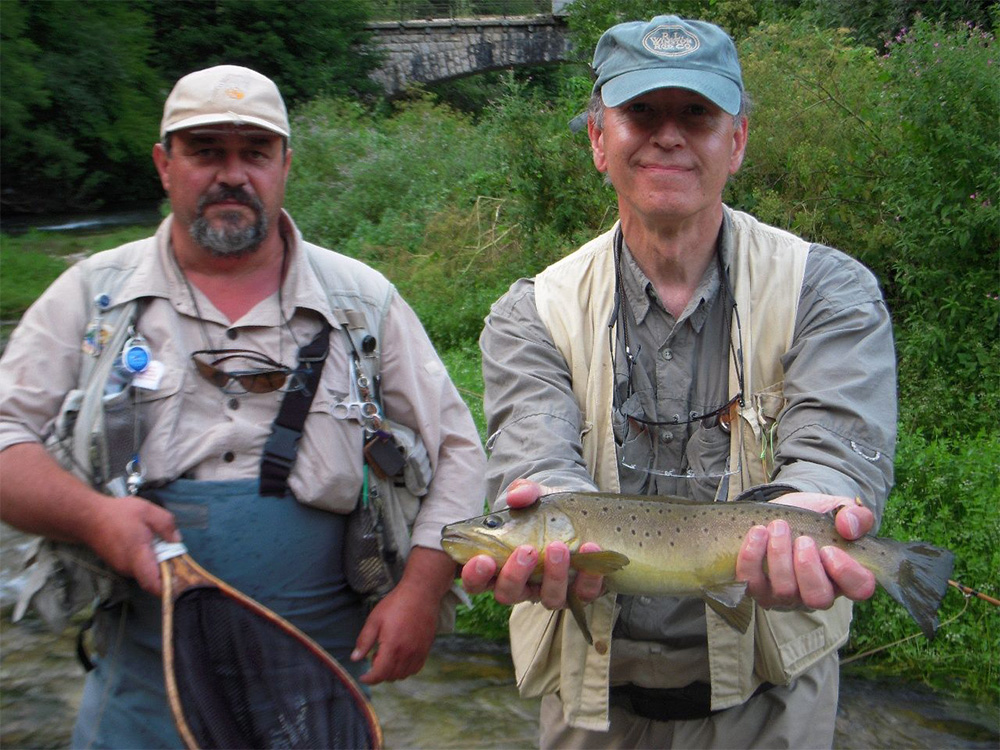
A successful trip
Do the Tuscan and Umbrian streams have the best trout fishing in the world? Possibly not, but when one adds the varieties of dry fly fishing to the unusual and perhaps unique strains of brown trout, as well as the northern Italian scenery, wines, architecture, food, and people, the package surely provides one of the world’s best experiences.
Information
The closest airport is in Florence, but the region is accessible by rental car, train, and bus. The two guides serving the area are Moreno and his guiding partner, Luca Castellani, and you will be able to find details about the streams and fishing seasons on both their websites. Moreno’s is mbrods.com, and Luca’s is info@lucacastellani.it
Since both Moreno and Luca are fluent in English, you don’t need to be concerned if your Italian is no better than mine. Moreno, having grown up in South Africa, not only uses “the King’s English” well, but also sounds wonderful doing it.
One can obtain fishing permits for the streams at these spots.
Tevere: Day tickets at the Piccini Impianti gas station in Sansepolcro (the station is closed on Sundays).
Nera: Permits from the information point in the centre of the village of Borgo Cerreto.
Lima: Rudy Bar sells day-tickets for the Lima. It is located at Val di Lima, 72, 55022 Bagni di Lucca.
Subscribe to our magazine for endless articles like this one.



